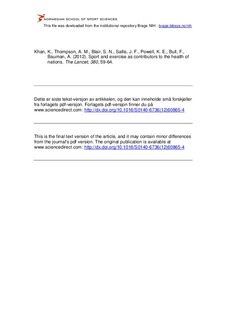| dc.contributor.author | Khan, Karim M. | |
| dc.contributor.author | Thompson, Angela M. | |
| dc.contributor.author | Blair, Steven N. | |
| dc.contributor.author | Sallis, James F. | |
| dc.contributor.author | Powell, Kenneth E. | |
| dc.contributor.author | Bull, Fiona C. | |
| dc.contributor.author | Bauman, Adrian | |
| dc.date.accessioned | 2013-10-08T07:56:41Z | |
| dc.date.available | 2013-10-08T07:56:41Z | |
| dc.date.issued | 2012-07-07 | |
| dc.identifier | Seksjon for idrettsmedisinske fag / Department of Sports Medicine | |
| dc.identifier.citation | The Lancet. 2012, 380, 59-64 | no_NO |
| dc.identifier.issn | 1474-547X | |
| dc.identifier.uri | http://hdl.handle.net/11250/171216 | |
| dc.description | I Brage finner du siste tekst-versjon av artikkelen, og den kan inneholde ubetydelige forskjeller fra forlagets pdf-versjon. Forlagets pdf-versjon finner du på www.sciencedirect.com: http://dx.doi.org/10.1016/S0140-6736(12)60865-4 / In Brage you'll find the final text version of the article, and it may contain insignificant differences from the journal's pdf version. The definitive version is available at www.sciencedirect.com: http://dx.doi.org/10.1016/S0140-6736(12)60865-4 | no_NO |
| dc.description.abstract | Self-reported rates of participation in sport vary by country. In the UK, about 40% of men and women aged 16 years or older participate in at least one sport every week. Although few data exist to assess trends for participation in sport, there is little evidence of change in the past decade among adults. Large cohort studies suggest that such participation in sport is associated with a 20-40% reduction in all-cause mortality compared with non-participation. Randomised trials and crossover clinical studies suggest that playing sport is associated with specific health benefits. Some sports have relatively high injury risk although neuromuscular training programmes can prevent various lower extremity injuries. Clinicians can influence a large number of patients through brief interventions that promote physical activity, and encouragement toward participation in sport for some physically inactive patients qualifies as evidence-based therapy. Exercise might also be considered as a fifth vital sign and should be recorded in patients' electronic medical records and routine histories. | no_NO |
| dc.language.iso | eng | no_NO |
| dc.publisher | Elsevier | no_NO |
| dc.subject | adolescent | no_NO |
| dc.subject | adult | no_NO |
| dc.subject | aged | no_NO |
| dc.subject | athletic injuries, etiology | no_NO |
| dc.subject | child | no_NO |
| dc.subject | exercise, physiology | no_NO |
| dc.subject | female | no_NO |
| dc.subject | health promotion, organization & administration | no_NO |
| dc.subject | health status | no_NO |
| dc.subject | human | no_NO |
| dc.subject | male | no_NO |
| dc.subject | middle aged | no_NO |
| dc.subject | physical fitness, physiology | no_NO |
| dc.subject | physician's role | no_NO |
| dc.subject | risk factors | no_NO |
| dc.subject | sports, physiology and statistics & numerical data | no_NO |
| dc.subject | young adult | no_NO |
| dc.title | Sport and exercise as contributors to the health of nations | no_NO |
| dc.type | Journal article | no_NO |
| dc.type | Peer reviewed | no_NO |
| dc.subject.nsi | VDP::Medical disciplines: 700::Basic medical, dental and veterinary science disciplines: 710 | no_NO |
| dc.subject.nsi | VDP::Medical disciplines: 700::Clinical medical disciplines: 750 | no_NO |
| dc.subject.nsi | VDP::Medical disciplines: 700::Sports medicine: 850 | no_NO |
| dc.source.journal | The Lancet | |
| dc.identifier.doi | 10.1016/S0140-6736(12)60865-4 | |
